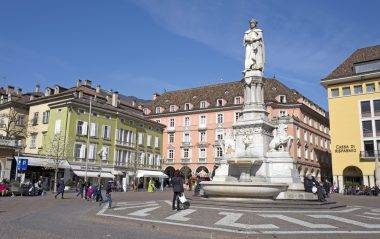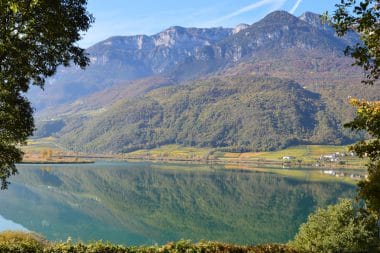In the Italian South Tyrol, an urban highlight awaits: Bolzano. The university town is framed by the alpine panorama of the region and today functions as the provincial capital of South Tyrol. The largest city in South Tyrol is correspondingly versatile with its cultural and tourist opportunities. It is a centre of the culturally multifaceted and distinctive region of South Tyrol that is well worth visiting. If you want to spend your holiday in the Italian autonomous province south of the Austrian Tyrol, Bolzano should not be missed.
Experience South Tyrol – History, culture and culinary delights in Bolzano
The most striking reasons for the tourist attractiveness of the South Tyrolean city are grouped around Bolzano: the alpine foothills of the Fiemme Valley Alps, Sarntal Alps and the Nornsberg Group. With its Alpine panorama, the city impressively underlines how closely South Tyrol is interwoven with the nature and culture of Alpine life. The lively home of more than 100,000 inhabitants also stands for a rural connection and is of enormous importance for the region, in whose conurbation about 250,000 people are at home. The city region was already populated in prehistoric times – which made the enormous attraction of the region clear early on. Finally, in the Middle Ages, an important settlement grew up here, which today has become an irreplaceable centre of South Tyrol.
The historic alleys, castles and sacred buildings are a reminder of the multifaceted history and are thus an important starting point for understanding South Tyrol culturally and touristically. South Tyrol’s winegrowing is flourishing in the surrounding area, which is known for regionally distinctive grape varieties such as Vernatsch and Lagrein. From Tramin, about 25 kilometres to the south, comes the world-famous Gewürztraminer. South Tyrolean cuisine, the facets of which can also be discovered in Bolzano, is characterised by bread varieties such as Vinschgauer, Räuscherfleisch and bacon, soups and Schupfnudeln as well as specialities such as Schöpsernes, Strauben and Krapfen. If you want to take a culinary tour in South Tyrol, Bolzano is the right place for you.
Castles, religious buildings and museums – Places of interest in Bolzano

Picturesque and historic streets, striking arcades and market squares characterise the old centre of Bolzano. Johann Wolfgang von Goethe stayed in Bolzano on his trip to Italy in the late 18th century, as evidenced by the Goethe Street named after him and the nearby fruit market, which Goethe described in detail at the time in his work of the same name, Italian Journey. The central square of Bolzano is the Walther Square, which commemorates another poet: Walther von der Vogelweide. The Walther monument – a marble statue with a fountain – in the heart of the square is dedicated to the medieval poet. In Bindergasse you can discover some rustic inns and old buildings. Here, in the historic Gasthof zum Pfau, the Perlaggen card game was invented around 1833, which is now recognised by UNESCO as an intangible cultural heritage.
Bolzano is also attracting greater attention thanks to the South Tyrolean Museum of Archaeology, where the world-famous man from the Tinsenjoch, also known as Ötzi, is kept. The museum, which opened in the 90s, contains archaeological finds, mainly from the Alpine region, which illuminate various historical epochs starting with the Stone Age. There are also regular special exhibitions. Visitors interested in culture can discover the Municipal Museum and the South Tyrol Museum of Nature in Bolzano at the same time. The mountaineer and adventurer Reinhold Messner is responsible for the Messner Mountain Museum, some of whose exhibits can also be seen in Bolzano.
The long and interesting history of the region is remembered by the many castles and castle buildings in and around the city region. One of the most famous buildings of this kind is Runkelstein Castle, which was built in the 13th century in today’s city region of Bolzano. The building is known nationwide thanks to its medieval frescoes, some of which are very well preserved. In the green scenery near Bolzano lies Maretsch Castle, which was built in the same era as Runkelstein Castle – in the 13th century. Sightseeing tours and events bring visitors closer to the idyllically situated castle and its history in a variety of ways. Some of Bolzano’s important sacred buildings also present themselves magnificently to travellers. One of the most famous is certainly the Cathedral of Bolzano – also known as the Cathedral of the Assumption of the Virgin Mary. As early as the 12th century, a predecessor building in Romanesque style stood here, and today’s late Gothic building was built around 1300. With its rich culture and multifaceted sights, Bolzano presents itself as an important gateway to the South Tyrol region – and a highlight for all travellers to Italy, as Goethe already knew.
Excursions – Alpine nature and South Tyrolean sightseeing

If you stop for a bite to eat in Bolzano, you will find yourself directly in the alpine region of South Tyrol – with all its natural highlights and hiking trails. The South Tyrolean Wine Road with its vineyards and its green natural beauty also runs along here. One of the popular local recreation destinations for nature lovers is Lake Caldaro, about 20 kilometres south of Bolzano. The lake, which was formed during the last ice age, is just as much a hotspot for holiday recreation as it is for winegrowing. The region is also home to the two idyllically situated Monticolo lakes. Bolzano is a good starting point for getting to know the most famous sights in South Tyrol – about 30 kilometres to the southeast is the idyllic Lake Carezza, the beautiful wine village of St. Magdalena with its mountain panorama is not far from the city centre, and day trips to Lake Braies and other top destinations are also possible. One thing is clear: the whole beauty of South Tyrol unfolds at the gates of Bolzano.


